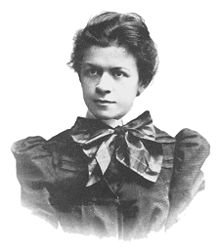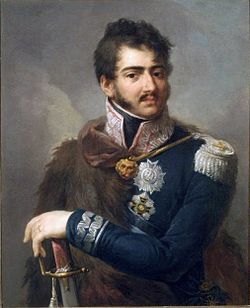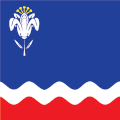Šabac
Šabac
Шабац (Serbian) | |
|---|---|
| |
Šabac City Square Šabac Courthouse Šabac Cultural Centre Hotel "Sloboda" Church of St. Peter and St. Paul Šabac Library | |
|
UTC+2 (CEST) | |
| Postal code | 15000 |
| Area code | +381(0)15 |
| Official languages | Serbian[3] |
| Climate | Cfb |
| Website | www |




Šabac (Serbian Cyrillic: Шабац, pronounced [ʃâbat͡s]) is a city and the administrative centre of the Mačva District in western Serbia. The traditional centre of the fertile Mačva region, Šabac is located on the right banks of the river Sava. According to the 2011 census[update], the city proper has population of 51,163, while its administrative area comprises 105,432 inhabitants.
Name
The name Šabac was first mentioned in
History
This section needs additional citations for verification. (February 2016) |
Archaeological evidence attests to more permanent settlement in the area from the Neolithic.[4] In the Middle Ages, a Slavic settlement named Zaslon existed at the current location of Šabac.[4] The settlement was part of the Serbian Despotate until it fell to the Ottoman Empire in 1459.
In 1470, the Ottomans built the first
Until the 19th century, Šabac was mostly under Ottoman administration, but control of the town changed hands several times between the Ottoman Empire and the
Šabac became a site of importance in Serbian history in the
The Ottoman army evacuated the fort of Šabac in 1867, marking the end of the Ottoman presence in the area. The first newspaper in the Kingdom of Serbia was printed in Šabac in 1883, and the town was also the first in Serbia where women started visiting kafanas (pubs) on Sunday afternoons, as was customary for men.

The town prospered until the
In 1918, the town became a part of the newly formed
Demographics
| Year | Pop. | ±% |
|---|---|---|
| 1948 | 16,243 | — |
| 1953 | 19,894 | +22.5% |
| 1961 | 30,352 | +52.6% |
| 1971 | 42,075 | +38.6% |
| 1981 | 52,177 | +24.0% |
| 1991 | 54,637 | +4.7% |
| 2002 | 55,163 | +1.0% |
| 2011 | 53,919 | −2.3% |
| 2022 | 51,163 | −5.1% |
| Source: [7] | ||
According to the 2022 census results, the city of Šabac has a population of 105,432 inhabitants.
Ethnic groups
The ethnic composition of the city of Šabac (as of 2011 census):
| Ethnic group | Population | % |
|---|---|---|
| Serbs | 110,642 | 95.48% |
| Roma | 1,902 | 1.64% |
Muslims |
393 | 0.34% |
| Croats | 165 | 0.14% |
| Yugoslavs | 123 | 0.11% |
| Others | 2,659 | 2.29% |
| Total | 115,884 |
Local communities
Urban local communities
Rural local communities

Economy
Prior to 1990, Šabac had one of the best developed economies among cities in Yugoslavia. However, international sanctions against Yugoslavia during the Bosnian War provoked the shutdown of the Zorka plant, which was the main enterprise in Šabac. Many other major local firms like "Šapčanka", "Izgradnja", and "Nama" also shut down during this period.
The main industries of Šabac today are agriculture, transportation and food production. Since 2000, some of the more important companies are diary plant Mlekara Šabac,
The following table gives a preview of total number of registered people employed in legal entities per their core activity (as of 2022):[9]
| Activity | Total |
|---|---|
| Agriculture, forestry and fishing | 217 |
| Mining and quarrying | 27 |
| Manufacturing | 10,969 |
| Electricity, gas, steam and air conditioning supply | 230 |
| Water supply; sewerage, waste management and remediation activities | 472 |
| Construction | 2,122 |
| Wholesale and retail trade, repair of motor vehicles and motorcycles | 6,105 |
| Transportation and storage | 2,413 |
| Accommodation and food services | 855 |
| Information and communication | 369 |
| Financial and insurance activities | 502 |
| Real estate activities | 87 |
| Professional, scientific and technical activities | 1,230 |
| Administrative and support service activities | 591 |
| Public administration and defense; compulsory social security | 1,499 |
| Education | 2,198 |
| Human health and social work activities | 2,232 |
| Arts, entertainment and recreation | 450 |
| Other service activities | 677 |
| Individual agricultural workers | 2,300 |
| Total | 35,545 |

Sports
There are several sports societies in Šabac:
- FK Mačva Šabac
- RK Metaloplastika
- VK Šabac
- Basketball club Šabac
- Football club Borac
- Boxing club Šabac
- Female handball club Medicinar
- Kayak club "Zorka color" Šabac
- Wrestling club Knight Šabac
Local media
Radio stations
|
TV stations
|
Newspapers
|
Education


Elementary schools
- OŠ "Sele Jovanović"
- OŠ "Nikolaj Velimirović"
- OŠ "Vuk Karadzić"
- OŠ "Stojan Novaković"
- OŠ "Nata Jeličić"
- OŠ "Janko Veselinović"
- OŠ "Laza Lazarević"
High schools
- Šabačka gimnazija (Šabac Grammar School)
- High agriculture school
- High medicine school "Dr Andra Jovanović"
- High economical-commercial school
- High chemical and textile school
- High technical school
- High music school Mihailo Vukdragović
- High art school
Private centres of education
Transportation
Roads
The length and status of roads in the city are:
- Main roads 59.9 km (37.2 mi) (all asphalt)
- Regional roads 111.4 km (69.2 mi) (all asphalt)
- Local roads 304.2 km (189.0 mi) (187.8 km (116.7 mi) asphalt)
- Unconventional roads 2,700 km (1,678 mi) (only 20 km (12 mi) asphalt)
- City streets 10 km (6 mi)
The Ruma-Šabac motorway, with a new 1,300-metre bridge on the Sava River, connects Srem and Mačva and was completed on time. The freeway from Ruma to Šabac is 24.6 kilometres long, including the Sava bridge and its related parts. This includes 440 meters connected to the Fruška Gora Corridor, 22.08 kilometers of road, the 1.335-kilometer-long Sava Bridge, and 700 meters of section 3 leading to the Drenovac Interchange.

Railway

Šabac railway station is served by a Serbian Railways' branch line connecting to the main Croatia to Belgrade railway at Ruma. A former line continued from the station to connect Serbia with Bosnia and Herzegovina. A branch which connected this line with Bogatić (Petlovača - Bogatić) is locked out. The railway is used for the transport of goods and raw materials for the Zorka factory and passenger transport to Ruma.
Politics
Seats in the city council won in the 2004 local elections: [1] Archived 2012-02-05 at the Wayback Machine
- Democratic Party - Serbian Renewal Movement (25)
- Serbian Radical Party (13)
- Democratic Party of Serbia(11)
- Socialist Party of Serbia (8)
- Strength of Serbia Movement (6)
- G17 Plus (4)
- People's Peasant Party (2)
- Group of the citizens "The voice of the people" (2)
Non-government organizations in Šabac
According to unofficial data, in the city of Šabac, there are over 300 registered non-government organizations, with wide variety of activities and different primary goals. Traditionally, the most active are those organizations whose primary goals are humanitarian, protection of the rights of persons with disabilities, protection of the rights of ethnic minorities, protection of the vulnerable social categories, ecology, etc.
Beside traditionally active organizations in Šabac, there are non-government organizations which unites young people in purpose of protecting their own rights. Under the social category of youth (young people) are those who are not older than 30, and not younger than 15 years, according to Ministry (Department) of youth and sports, of the Republic of Serbia.
Some of the most active organizations in Šabac are: Youth Umbrella (Omladinski Kišobran), Caritas - Šabac, Roma for Roma, Human heart of Šabac (Humano srce Šapca), NGO Light, NGO Ecos.
Notable people



- Branimir Ćosić, writer and journalist
- Branislav Lečić, actor
- Draga Ljočić, the first female doctor in Serbia
- Dragiša Lapčević, politician, journalist, historian
- Dušan Ninić, novelist
- Isidora Sekulić, writer
- Janko Veselinović, writer
- Jela Spiridonović-Savić, poet
- Jevrem Obrenović, younger brother of Prince Miloš Obrenović, governor of the Šabac nahija (district)
- Jovan Cvijić, geographer, president of the Serbian Royal Academy, rector of the Belgrade University
- Józef Poniatowski, Polish leader, general
- Sava Petrović, botanist
- Kosta Abrašević, poet
- Laza Lazarević, doctor, writer
- Ljubiša Jovanović, actor
- Mileva Marić, Serbian physicist
- Milić Stanković, painter
- Milorad Popović Šapčanin, poet, writer, dramatist, pedagogue and educational reformer
- Sasha Knezev, Serbian American filmmaker and author
- Slobodan Jovanović, historian, lawyer, literary critic and politician
- Stanislav Vinaver, avant-garde writer
- Stojan Novaković, historian, scholar, writer, literary critic, translator, politician and diplomat
- Šaban Šaulić, folk singer
- Veselin Vujović, handball player
- Vladimir Jovanović, philosopher, political theorist, economist, politician, political writer
- Vladislav Lalicki, production designer, costume designer, painter
- Živojin Pavlović, film director, writer
- Lyenko Urbanchich (1922–2006), Australian politician
- Jasmina Vujic, nuclear engineering professor at Berkeley, 1st female nuclear engineering department chair in the US
- Alex Lifeson, guitarist of Canadian rock band Rush born to ethnic Serbian parents from Šabac
Sportspeople:
- Mile Isaković, handballer
- Milutin Dragićević, handballer
- Miroslav Đukić, footballer
- Nemanja Matić, footballer
- Aleksa Purić, footballer
Coat of arms of Šabac and armorial flag
There are three versions of the coat of arms of Šabac: the Primary, Middle, and Large.
-
Primary coat of arms
-
Middle coat of arms
-
Šabac Armorial flag
Twin towns - sister cities
Šabac is twinned with:[12]
 Argostoli, Greece
Argostoli, Greece Fujimi, Japan
Fujimi, Japan Kiryat Ata, Israel
Kiryat Ata, Israel Kralupy nad Vltavou, Czech Republic
Kralupy nad Vltavou, Czech Republic
References
Footnotes
- ^ "Municipalities of Serbia, 2006". Statistical Office of Serbia. Retrieved 2010-11-28.
- ISBN 978-86-6161-228-2. Retrieved 2023-04-30.
- ^ "Статут Града Шапца" [City of Šabac Statute] (in Serbian). City of Šabac. Retrieved 22 March 2025.
- ^ a b c "Zvanična prezentacija grada Šapca - Istorija". Archived from the original on 2015-11-20. Retrieved 2011-07-29.
- )
- ^ Anderl and Manoschek. 2001 Gescheitert Flucht. Vienna: Mandelbaum.
- ^ "Comparative overview of the number of population in 1948, 1953, 1961, 1971, 1981, 1991, 2002, 2011. and 2022". Statistical Office of the Republic of Serbia.
- ^ Mikavica, A. (3 September 2017). "Slobodne zone mamac za investitore". politika.rs (in Serbian). Retrieved 17 March 2019.
- ^ "MUNICIPALITIES AND REGIONS OF THE REPUBLIC OF SERBIA, 2023" (PDF). stat.gov.rs. Statistical Office of the Republic of Serbia. Retrieved 20 September 2024.
- ^ http://www.kingscollege.rs/ Archived July 17, 2009, at the Wayback Machine
- ^ "Pygmalion School of English".
- ^ "Градови побратими". sabac.rs (in Serbian). Šabac. Archived from the original on 2018-09-01. Retrieved 2020-01-07.













